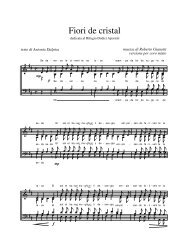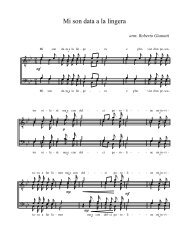Latin texts and notes - Gianotti Roberto
Latin texts and notes - Gianotti Roberto
Latin texts and notes - Gianotti Roberto
Create successful ePaper yourself
Turn your PDF publications into a flip-book with our unique Google optimized e-Paper software.
The Vespers of the Blessed Virgin as a work of figurative art<br />
Music is the h<strong>and</strong>maiden of oration. There is, however, a substantial difference between profane <strong>and</strong> sacred<br />
music: in the former, the <strong>texts</strong> are various <strong>and</strong> always new, created by poets to express the infinite variety of<br />
human feelings through the words that the music depicts; in the latter, the sacred text is unchanging (mass,<br />
psalms, magnificat) or recurrent (motets, hymns) <strong>and</strong> not necessarily a search for the expression of the mood<br />
of every single word.<br />
I believe that the Vespers of the Blessed Virgin is a work of figurative art. The psalms seek a representation of<br />
the Word <strong>and</strong> with this the particular image of God evoked by the text reinforced by the music. Like a painter<br />
Monteverdi illustrates the sentiment now of a mighty, vindictive god (Dixit Dominus), now of a sweet, affectionate<br />
god (Laudate pueri). His music lets us hear the voice of a god who is in turn authoritarian, then even<br />
“maternal” <strong>and</strong> merciful, or, in the psalm Laetatus sum, it infuses a profound sense of peace (the word pax is recurrent)<br />
from the famous opening in crotchets of the basso continuo which depicts the pilgrim at the end of<br />
his journey, when his slow step halts before the gr<strong>and</strong> walls of an idealised Jerusalem. This music, which is the<br />
true soul of the true Baroque in music, seems to become not only painting but even sculpture in Monteverdi’s<br />
h<strong>and</strong>s; to the sounds <strong>and</strong> the singing he brings three-dimensional forms that are supple <strong>and</strong> enveloping, ductile<br />
<strong>and</strong> coloured. In the two psalms Nisi Dominus <strong>and</strong> Lauda Jerusalem, on the other h<strong>and</strong>, the choral nature of<br />
warning <strong>and</strong> advice in the former <strong>and</strong> the exaltation of god’s works in the latter, are representations of the<br />
choral aspect of the voices which, responding to each other, unanimously celebrate the gr<strong>and</strong>eur of a luminous<br />
divinity. The same voices invoke a shining “Sancta Maria” in the Sonata, which may rightly be defined a marvellous<br />
work of baroque architecture.<br />
The word <strong>and</strong> voice of God described through music were at the same time the voice <strong>and</strong> image of the Church:<br />
the illustration of these different characters infused in the audience of the faithful a feeling of reverential awe<br />
for an institution that was both gr<strong>and</strong>iose <strong>and</strong> authoritarian (Domine ad adiuv<strong>and</strong>um, Nisi Dominus, Magnificat)<br />
but also the image of a maternal church that redeems the inane from wretchedness (de stercore) raising them<br />
to the rank of Prince or lulling them in the warmth of her embrace, like a loving mother for whom Mary becomes<br />
a personification. The tempo of the major sesquialtera which Monteverdi prescribes in the psalm Laudate pueri<br />
where the text says “Qui abitare facit sterilem in domo matrem filiorum lætantem” is the most extraordinary example<br />
of this, probably the point in which we can most clearly notice the shocking difference compared to a<br />
performance in dance time: here a clear image of a mother lulling her children <strong>and</strong> singing a sweet lullaby is expressed<br />
through the eight-part song. In the Marian pieces (Audi coelum, Ave Maris Stella or again in the Sonata)<br />
as in the motets, this humanisation is absolutely clear <strong>and</strong> incredibly appealing.<br />
In the Nigra sum, especially, it is stunning to note how the two characters, the one of the maiden, intimated<br />
<strong>and</strong> loving yet sure of her beauty, the one of the passionate man brimming with desire for her, are so precisely<br />
expressed through the humanisation of the song for solo voice: a love story consumed in the space of three<br />
minutes of true theatre in music. The words of Ludovico Zacconi, who had fully understood the tendency towards<br />
“realism” which became almost embarrassing in church, come to mind: “… nowadays many singers delight<br />
in singing solo Quam pulchra es amica mea, quam pulchra es. Tota pulchra es amica mea, formosa mea. Fulcite me<br />
Floribus quia amore langueo with other things, <strong>and</strong> God knows with what spirit <strong>and</strong> intention they sing. Let this be<br />
said for zeal of God, <strong>and</strong> to warn the singers that, singing in churches, they should remember they are singing to<br />
praise the Lord <strong>and</strong> not to satisfy their own loving passions 5 .”<br />
Listening to Audi coelum we gain a clear idea of the experience Monteverdi had already acquired in the fifth act<br />
of Orfeo: the analogy between the praying I of the motet <strong>and</strong> the song of Orfeo, shows us the 1610 Vespers as<br />
though they were a second element, complementary to the Favola in Musica of 1607: two works united in a<br />
single theatrical project. It seems to me that the music thus st<strong>and</strong>s on a par with the figurative arts becoming,<br />
not just an authentic theatrical scene but also painting, sculpture <strong>and</strong> architecture at the same time.<br />
For the interpreter-performer the first element to be sought is not then in the score, but in thorough knowledge<br />
of the sacred text <strong>and</strong> the concept that it is to impress on the listener’s heart. I would add that as happens<br />
with actors in the theatre, we must literally “enter into the role”, experience those feelings of devotion, fear, re-<br />
12















